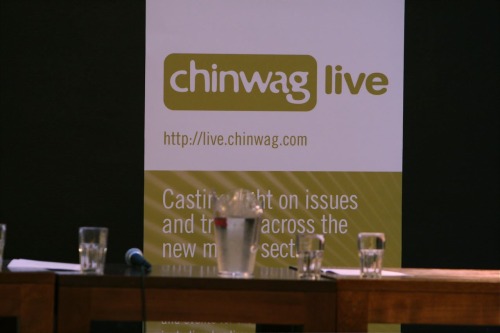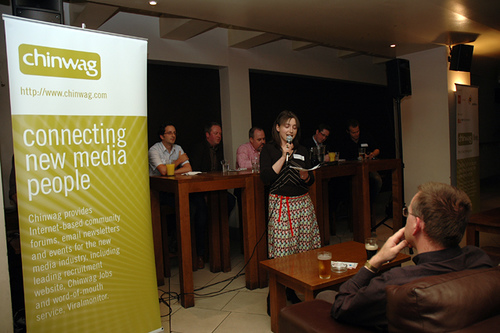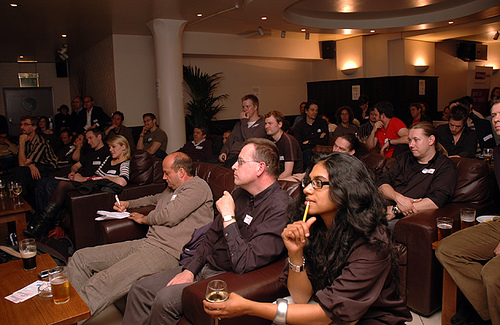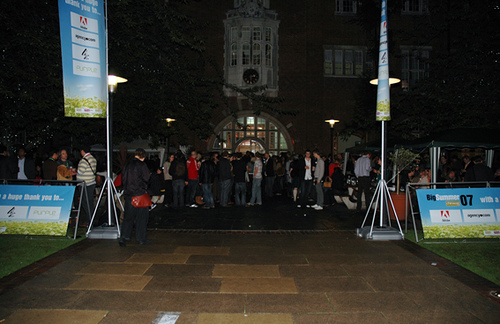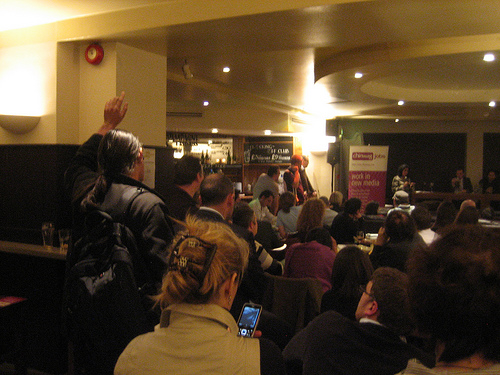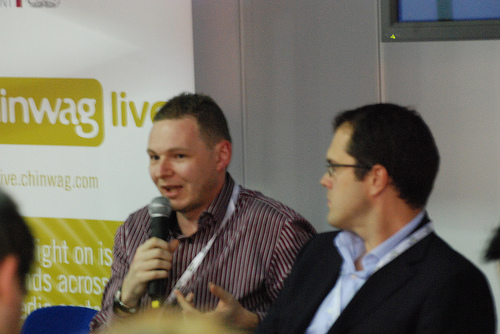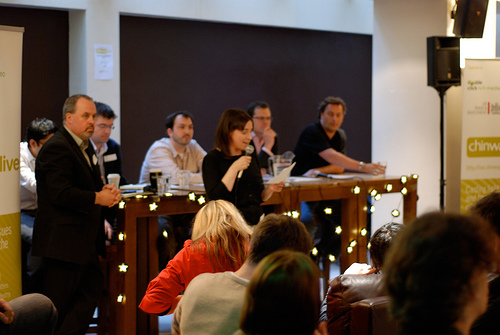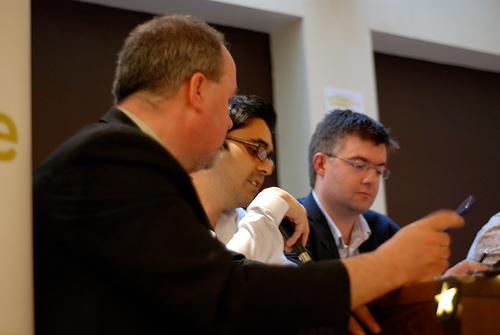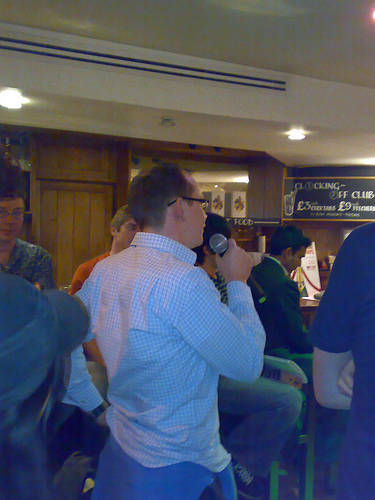Potent openers are thin on the ground at events, mine especially. Having often developed and programmed the events, I’m normally found delivering safety instructions and other such vital messages in a vaguely ironic monotone (see photos).
So props to Steve Bowbrick for his scenesetting observation at Chinwag Live: Media Widgetised on Wednesday 16th May that the opposing life forces of disintegration and re-formation are encapsulated in the widgetisation of media.
Getting the second event in Widget Week properly underway, Steve canvassed the panel for their definition of a widget and the answers were both resonant and diverse. For their answers, you have to listen to the podcast due this Thursday 24th May.
PANEL:
Mark Taylor – Head of Content, Eircom & founder, Sleevenotez (blog)
George Berkowski – Head of Internet Strategy, BT Retail
Fergus Burns – CEO & Founder, nooked
Jonathan Gabbai – Solutions Manager, eBay
Kaj Häggman – Business Development Manager & Inventor, WidSets (blog)
Chair: Steve Bowbrick
So are widgets internet famous? 😉 George Berkowski, Head of Internet Strategy at BT Retail flagged-up Adsense as the most successful widget to date. He also cited Photobucket, which gets 1% of all internet traffic in the US.
Nooked CEO Fergus Burns was quick off the mark with some headline info about the widget economy. Last year was the year retailers and advertisers started asking “how do I get onto Myspace and onto Vista Gadgets?” You want your widget to be viral, but how do you drive traffic back to your site from RSS and the widget, Burns continued. The challenges ahead mean it has to be fun and it has to give value to the consumer (can you tell Fergus wasn’t giving away too much..?).
Kaj ‘Hege’ Häggman of Widsets stressed the widget proposition has to be simple. They now have 14,000 widgets in their library, 99% of which have been created by users. Doing profile-base widget recommendations is edging very close to advertising he noted.
Widgets – socking it to the portals?
Eircom Head of Content and Sleevenotez founder Mark Taylor explained that the “Kwaydo” engine that powers Sleevenotez (get more info by clicking on ‘Navigation’ on the Zythe homepage), is in fact a platform that powers what he terms “thin portals”.
He acknowledged that on the one hand – with Kwaydo – he is trying to disrupt portal models, but on the other – with his (Irish incumbent telco) Eircom hat on – to maintain them. He said widgets can extend your brand’s borders, but as a widget sceptic he is concerned that widgets are going to become another marketing and advertising tool.
Outfits like Ning and PeopleAggregator are going in one direction against the old portals, he said, but portals still have a role to play and while we are trying to figure out what that role is, it is clear that there is a value in aggregating large audiences. In turn, those portal-type aggregators can also provide access to exclusive content that you can then widgetise.
Utility versus monetisation?
eBay Solutions Manager Jonathan Gabbai stressed that widgets facilitate the distribution of content – which begs the question how do you monetize that? eBay is good for that because it is time-sensitive. The newly launched eBayToGo widget can be embedded on a blog or website giving you live updates on your auction. It this scenario, it’s important to have an open API, as has Amazon and Google, he added.
From the audience Pauli Visuri described a widget rather poetically as a “tear-off” from a website. Robin Gurney of (Estonian-based) Altex Marketing sounded a more cynical note, saying this monetized widget “sounded like a glorified version of affiliate marketing”.
Jonathan Gabbai concurred welcomingly that widgets do lend themselves to affiliate marketing. Someone else said the whole widget phenomenon must be like a “freak-out nightmare” for content owners and publishers, and George Berkowski noted that that is part of it, but there is also a real value for the user – the widget services from Slide, Photobucket and RockYou have great usability and utility for users. They have an altruistic and positive brand effect, and at the same time those companies are monetizing widgets very well.
Applications for and by the masses?
Kaj Häggman observed that it’s as much about allowing users to generate applications, and it’s a new paradigm that that not only gives users control to create their own apps, it’s also about giving control back to the developers. The mobile industry needs to be able to talk the language of the web industry, he stressed; a remark that triggered a flurry of comments about how the mobile industry’s business models were being put on the line by the arrival of the mobilized web, hence their reluctance to embrace it until the last moment possible.
Steve Bowbrick mused on the impact on site owners who have to host the applications and content of others via embedded widgets; the prospect of that happening on phones struck him as even more iffy.
One widget into 25 platforms does not compute…
A delegate from Profero noted that the arrival of Apollo from Adobe opens out the Flash platform to developers and he suggested that this would make it all more popular and widespread. Fergus Burns countered that the recent launches of Silverlight (from Microsoft) and Apollo means that we will end now end up with about 25 different widget platforms that developers will have to develop differently for.
This issue was thrown into even sharper relief by Opera Software ’s Charles McCathieNevile two nights earlier at Mobile Monday: Mobile Widgets. If development work around incompatible widget platforms is not in itself going to become a barrier to the development of widgets, he reflected, support needs to cohere around the notion of a standardised widget spec which is validated by the W3C (more here).
Dave Markham from Vodafone wondered wasn’t it all more about making sure it all works. Vodafone want it to work with widget builders, he said, and he asked the panel whether it would be a better experience for mobile users with downloadable widgets or online widgets.
Widgets as symbiotic parasites
Kaj Häggman commented that a widget is a very personal thing and there is a possibility to put an ad in that space that is not intrusive. Jonathan Gabbai observed that the big question here was one of trust. For kids, you could see a widget as a Harry Potter sticky note. So does that mean it’s all pre-packaged content?
A widget can be classified as a web service, said Burns. Dave Hornick on Ventureblog reckons it can be symbiotic (the Harry Potter-type, providing value for both host and widget provider), or that such as found with Slide, which is a parasitic widget that makes revenue for the widget provider.
Steve then interjected with a vivid analogy of an ecosystem of parasitic widgets leeching around the place and monetizing the attention of hosts on the one hand, and benign widgets that that swung freely between the trees.
Personalisation and widgetised identity
George Berkowski cited the robust personalisation of SnapVine. In turn, he continued, you have the phenomenon of widgetised startpages, whereby you can go to a celebrity’s page, for example on Netvibes, and it has all her content aggregated, plus you can leave voicemails and comments on it.
Lingo allows you to do the same with video and audio. There’s nothing to download, sort of like Skype without the download.
Alex Cooper of 1UpSearch asked if the Widsets business model was one of collecting demographic information and he wondered how that will pan out – will we be spammed by Nokia? Häggman explained that it will be opt-in as they value peoples’ privacy. Steve commented that it all was a bit like widgets as Big Brother or CCTV on your desktop.
Widgets atomised or widgets humanised?
Mark Taylor cited the utility of a private banking widget and Fergus Burns flagged-up the Ding! widget produced by South West Airlines, noting that it had 2 million downloads and there was no privacy issue with that. Jonathan Gabbai remarked that there’s a difference between installation and download, for example, with Firefox you download the extensions but it’s a low barrier to entry.
Finally, Gavin O’Carroll of Rememble asked the kind of mind-melting question that I had hoped audience members might ask in a previous post about this event. Where does it stop? Can you widgetise widgets? For example, will we have banner ads in widgets, and is there any reason why you can’t advertise in widgets?
Check the podcast (due Thursday 24th) for attempted answers to that, as at that point my humble penning skills failed and minutes later chair Steve Bowbrick said it was a wrap.
Stowe Boyd (who discovered the event via Dopplr when he arrived in the UK that afternoon) remained quiet during the discussion but told me afterwards he thought the event was too focused on monetisation (he also tweeted this) and didn’t really look at the user. Fair dos, but isn’t it fair enough to examine potential business models when you want to make a living?
Freakout nightmare or scent of a persona..?
What I felt was also missing was the publisher and brand perspective in terms of future media (although there were plenty of mainstream media publishers in the audience) – how do they maintain their brand identity in the web feed, widget and mash-up space without hugely irritating or inconveniencing people, and how do they fund widgetisation? Alan Patrick is convinced advertising in feeds will fail (see his post on the event). So what will work?
The broader issues of widgetisation outlined in the event webpage were barely touched upon and I would like to have heard more from panellist Mark Taylor too. Check out Mike Butcher’s excellent post on Sleevenotes from back in December 2006 for more on what Mark is up to.
Priya told me later that evening she thought a widget was like a digital perfume. But then we started quibbling over whether she meant natural human scent, perfume or aftershave, and then whether or not we favoured aftershave. And so the lights went down and off I hobbled to Madame JoJo’s for the tail end of the book launch party for Richard Barbrook’s Imaginary Futures: From Thinking Machine to Global Village.
Yep, another Chinwag Live to remember when we’re in yr rockin chairz gluing captions to yr cats…. (cheers Ian). Hmm, did I already mention the photos?
——–
Please bear in mind my notes were sporadic and atomised 😉 For the complete lowdown on what was said, subscribe to the Chinwag Live podcast via RSS or iTunes.
